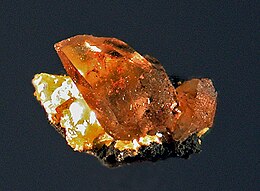
Back Kalomel Afrikaans كالوميل Arabic Calomelans Catalan Kalomel Czech Kalomel CSB Kalomel German Καλομέλας Greek Calomelano Spanish Kalomel Basque Calomel French
| Calomel | |
|---|---|
 Amber calomel crystals and bright yellow terlinguaite on gossan matrix, 3 mm. across | |
| General | |
| Category | Halide mineral |
| Formula (repeating unit) | (Hg2)2+Cl2 |
| IMA symbol | Clo[1] |
| Strunz classification | 3.AA.30 |
| Crystal system | Tetragonal |
| Crystal class | Ditetragonal dipyramidal 4/mmm (4/m 2/m 2/m) - |
| Unit cell | a = 4.4795(5) Å, c = 10.9054(9) Å; Z=4 |
| Identification | |
| Color | Colorless, white, grayish, yellowish white, yellowish grey to ash-grey, brown |
| Crystal habit | Crystals commonly tabular to prismatic, equant pyramidal; common as drusy crusts, earthy, massive. |
| Twinning | Contact and penetration twins on {112} |
| Cleavage | Good on {110}, uneven to imperfect on {011} |
| Fracture | Conchoidal |
| Tenacity | Sectile |
| Mohs scale hardness | 1.5 |
| Luster | Adamantine |
| Diaphaneity | Transparent to translucent |
| Specific gravity | 7.5 |
| Optical properties | Uniaxial (+); very high relief |
| Refractive index | nω = 1.973 nε = 2.656 |
| Birefringence | δ = 0.683 |
| Pleochroism | Weak, E > O |
| Ultraviolet fluorescence | Brick-red under UV |
| References | [2][3][4] |
Calomel is a mercury chloride mineral with formula Hg2Cl2 (see mercury(I) chloride). It was used as a medicine from the 16th to early 20th century, despite frequently causing mercury poisoning in patients.[5]
The name derives from Greek kalos (beautiful) and melas (black) because it turns black on reaction with ammonia. This was known to alchemists.[3]
Calomel occurs as a secondary mineral which forms as an alteration product in mercury deposits. It occurs with native mercury, amalgam, cinnabar, mercurian tetrahedrite, eglestonite, terlinguaite, montroydite, kleinite, moschelite, kadyrelite, kuzminite, chursinite, kelyanite, calcite, limonite and various clay minerals.[2]
The type locality is Moschellandsburg, Alsenz-Obermoschel, Rhineland-Palatinate, Germany.[3]
- ^ Warr, L.N. (2021). "IMA–CNMNC approved mineral symbols". Mineralogical Magazine. 85 (3): 291–320. Bibcode:2021MinM...85..291W. doi:10.1180/mgm.2021.43. S2CID 235729616.
- ^ a b The Handbook of Mineralogy
- ^ a b c Calomel on Mindat
- ^ Calomel on Webmin
- ^ Davis, L. E (2000-07-01). "Unregulated potions still cause mercury poisoning". Western Journal of Medicine. 173 (1): 19. doi:10.1136/ewjm.173.1.19. PMC 1070962. PMID 10903282.